Review: 2024 Toyota TRD Pro and Trailhunter excel at fast and slow
Do you want to go fast or go far? That’s the question Toyota Tacoma Chief Engineer Sheldon Brown posed when I asked how someone chooses whether to buy the 2024 Toyota Tacoma TRD Pro or Tacoma Trailhunter. Another question worth asking is, how much is in your budget?
Toyota’s off-road Tacoma flagship has been split in two, each with its own personality. The TRD Pro is meant to go fast over sand and dirt, while the Trailhunter is built to crawl over off-road obstacles.
The outgoing Tacoma TRD Pro was meant to be the do-everything Swiss Army knife of midsize pickup trucks, Brown explained. However, trying to be good at everything often makes a product mediocre at most things.
After spending time behind the wheel of both the 2024 Toyota Tacoma TRD Pro and Tacoma Trailhunter pickups, it’s clear the automaker focused each truck on its dedicated mission. However, neither truck is the off-road king of the hill.
Let’s go off-pavement and dig in.
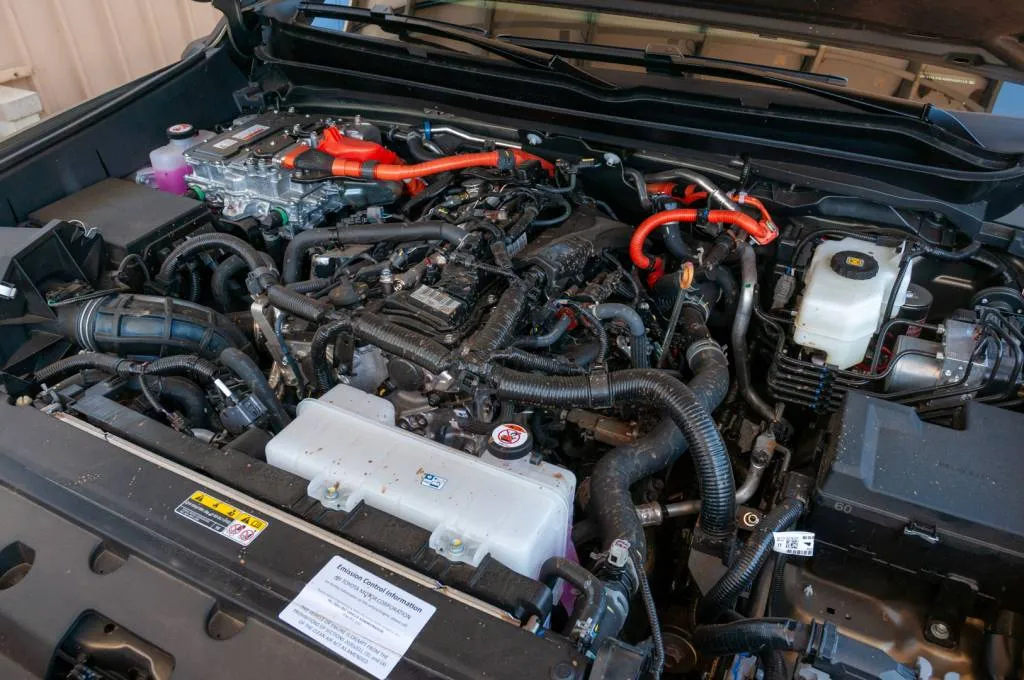
2024 Toyota Tacoma Trailhunter
2024 Toyota Tacoma TRD Pro and Trailhunter go hybrid
Every Tacoma TRD Pro and Trailhunter pickup is a hybrid. RIP to the old V-6.
Under the hood sits a 2.4-liter turbo-4 mated to an electric motor located in the 8-speed automatic transmission. Total output checks in at 326 hp and 465 lb-ft of torque. On paper those numbers outgun the Chevrolet Colorado ZR2 turbo-4’s 310 hp and 430 lb-ft. The Toyota also bests the Ford Ranger Raptor’s 430 lb-ft of torque rating, but falls short of beating the Raptor’s 405 hp number.
The hybrid system provides only decent fuel economy numbers at 22 mpg city, 24 highway, and 23 combined for both trucks. I didn’t get to drive these trucks on pavement, so I can’t comment on real-world fuel economy.
I did experience this powertrain on-road in a Tacoma Limited model lined with leather. Like other Hybrid Max-badged Toyotas, the hybrid powertrain is strong, but somewhat underwhelming, with no wallop of power off the line or on the highway despite the high torque number.
Off-road, the story is different, though it’s still a mixed bag. The electric motor contributes to immediate torque that provides plenty of grunt at low speeds and when crawling in the Trailhunter. Power delivery is smooth, as expected because Toyota has become the leader at hybrid power blending.
In the TRD Pro, however, once the electric motor’s boost trails off the turbo-4 simply doesn’t deliver the same kick in the pants as the larger 2.7-liter turbo-4 in the Colorado ZR2. Also, no Tacoma offers paddle shifters like the Ranger Raptor. Brown said the team thought about paddle shifters for the TRD Pro, but it wasn’t really sure how many people would use the manual shift capability. I would’ve while driving at high speeds off-road because if programmed correctly it allows for more control to stay in the power band when needed.
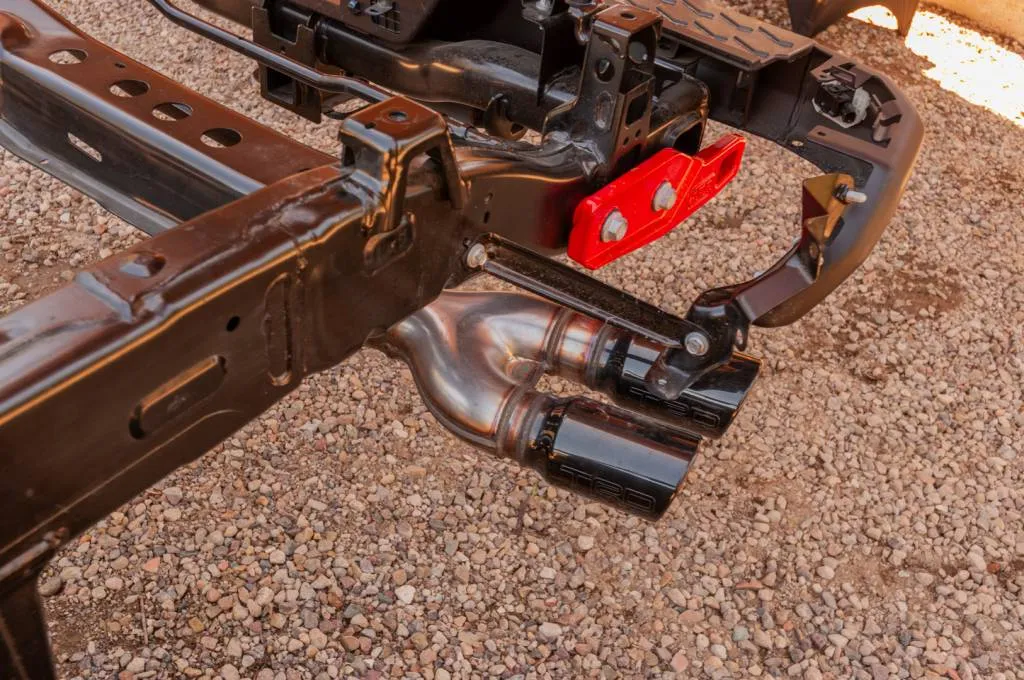
2024 Toyota Tacoma TRD Pro
The turbo-4’s noise, even with the performance exhaust of the Trailhunter and TRD Pro, isn’t in the same class as the throaty high-pitched turbo V-6 burble of the Ranger Raptor. It is notably deep for a turbo-4, though. That’s in part due to the TRD performance cat-back exhaust system. On the Trailhunter, the exhaust dumps out high just in front of the rear axle, where it’s tucked away from to prevent damage. On the TRD Pro, the exhaust splits into two welded black tips that exit on the driver side just behind the rear wheel.

2024 Toyota Tacoma TRD Pro, photo via Nathan Leach-Proffer
2024 Toyota TRD Pro aims for Raptor and ZR2
In some ways the Tacoma TRD Pro hits the mark and bests the competition, but in many ways it falls short.
The Tacoma TRD Pro can indeed go fast off-road, to a point, as I learned on a bumpy gravel road.
When I pointed the TRD Pro down the rock-strewn gravel fire road, my right-seat companion, Andy, a professional stunt driver, told me to hit the hump in the road at 40 mph. That speed would send the truck flying. Any faster and we might land and bury the nose into the ground, much less and we wouldn’t get the air I wanted. I hit 48 mph before the hump, then lifted as instructed by Andy. Our speed dropped to 36 mph as we crested the hump. The truck took flight for a few feet and landed softly.
“That wasn’t dramatic enough,” I told him, noting we were going to need to do that again.
The front tires hit the hump the second time with the speedometer at 46 mph, a little faster than instructed.
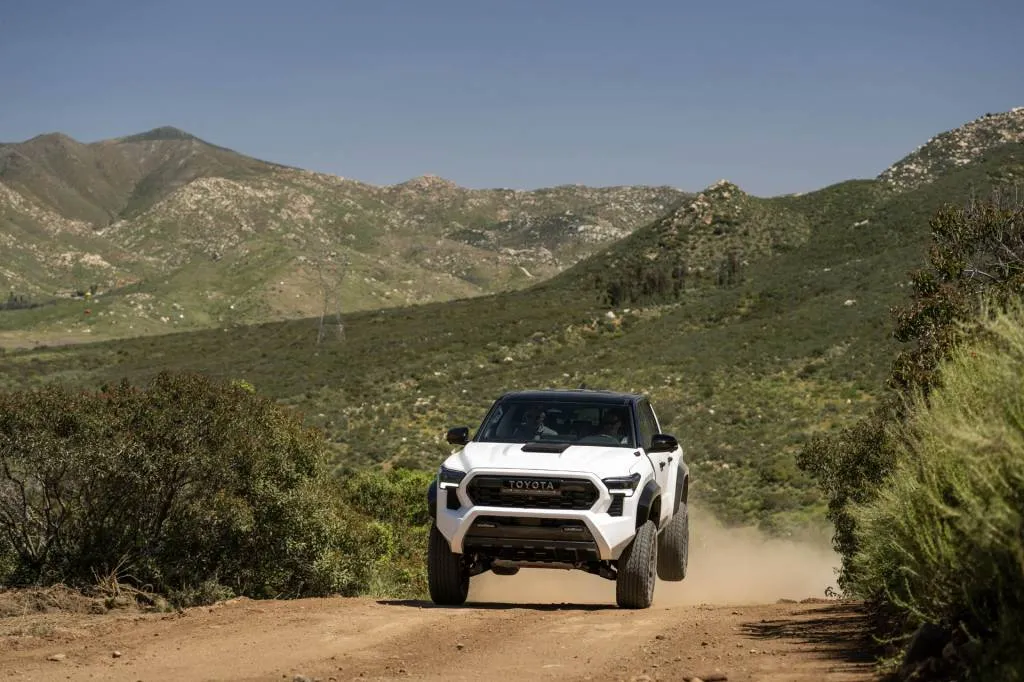
2024 Toyota Tacoma TRD Pro, photo via Nathan Leach-Proffer
When the truck landed the 2.5-inch Fox QX3 shocks with small piggyback remote reservoirs went to nearly full compression and took the hit. I don’t think the rear end hit the hydraulic Fox jounce bumpers (the Trailhunter doesn’t have these), but if they did, they took the blow so well I didn’t even notice.
Andy said I could now go as fast as I could comfortably see down the rest of the fire road. He was wrong. With the pedal buried I soon realized the truck was about to rattle apart if it went much faster. The shocks weren’t keeping up with all the bumps. I didn’t see my speed because I was watching for rocks so I wouldn’t blow apart the underside of the truck (been there, done that, sorry, Chevy). The hood was shaking so violently that I let off the throttle a bit. I could’ve gone faster, the truck I’m not so sure.

2024 Toyota Tacoma TRD Pro
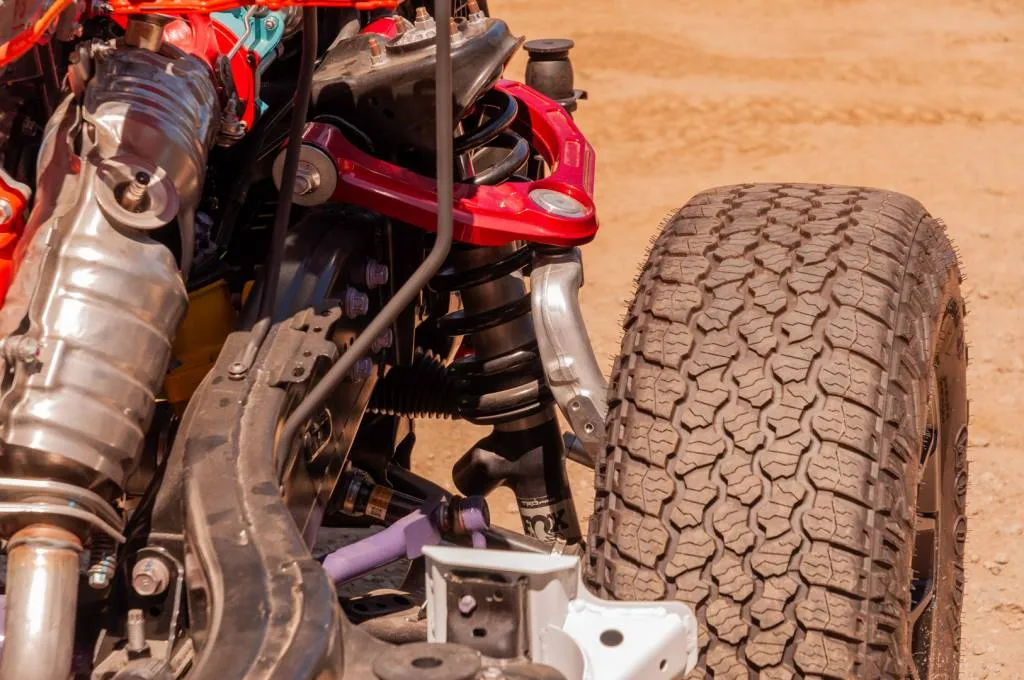
2024 Toyota Tacoma TRD Pro
Brown told me the three-way adjustable Fox shocks were set to level two. Level one is for road use. Level two is for fire roads, which is what we were on. Level three is meant for desert-style Baja driving with more compression damping. Apparently, I can see at Baja-level speeds. Brown noted that if he had known someone would be willing to go that fast down the fire road he would’ve switched the shocks to level three. Next time, Brown.
The TRD Pro’s steering weight was nearly ideal as I didn’t have to saw back and forth on the thick perforated TRD-branded steering wheel to keep the truck going straight.
Based on my time with both the Colorado ZR2 and Ranger Raptor, both trucks would have gone faster on the fire road, at least with the Tacoma’s Fox QS3 shocks set to Level 2. Unlike the TRD Pro, those trucks also don’t require a driver to manually turn a knob on each shock to adjust them, as the ZR2’s Multimatic DSSV shocks constantly adjust to conditions while the Raptor’s Fox Live Valve shocks adjust electronically based on the chosen drive mode.
The TRD Pro and Trailhunter are 3.0 inches wider than the base Tacoma SR5, which itself is about 3.0 inches wider than the outgoing SR5 model. With the 33-inch Goodyear Territory R/T tires tucked under the bulging fenders, it’s hulking in comparison to an older Tacoma. Sorry kids, 35s aren’t going to fit without rubbing.
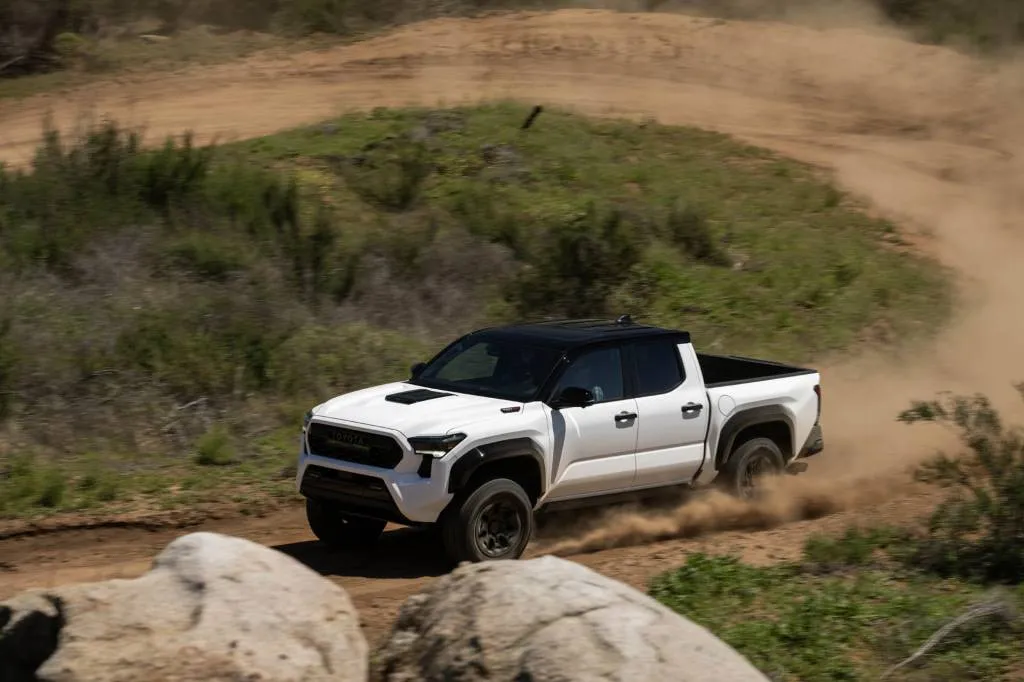
2024 Toyota Tacoma TRD Pro, photo via Nathan Leach-Proffer
That wide stance helped give the TRD Pro a stable feeling while blasting around corners and down straights in the dirt on a motocross course. The new coil-spring rear suspension kept things planted and the tires in contact with the earth for better traction. But full-time four-wheel drive is nowhere to be found unlike on a Colorado ZR2 and Ranger Raptor. That’s just being cheap, Toyota.
The various off-road modes of the Multi-Terrain Select system now work in 4Hi and 4Lo, and the crawl control system, which is like off-road cruise control, no longer clunks and thunks. Still, there’s no Baja mode or anything that truly kicks the TRD Pro’s powertrain in the pants. The off-road drive modes are limited to Mud, Dirt, and Sand. Coming around banked turns on the motorcross course, the powertrain sometimes bogged down and got caught flat footed. The transmission simply didn’t want to shift quickly enough. Can we get a Baja mode, Toyota?
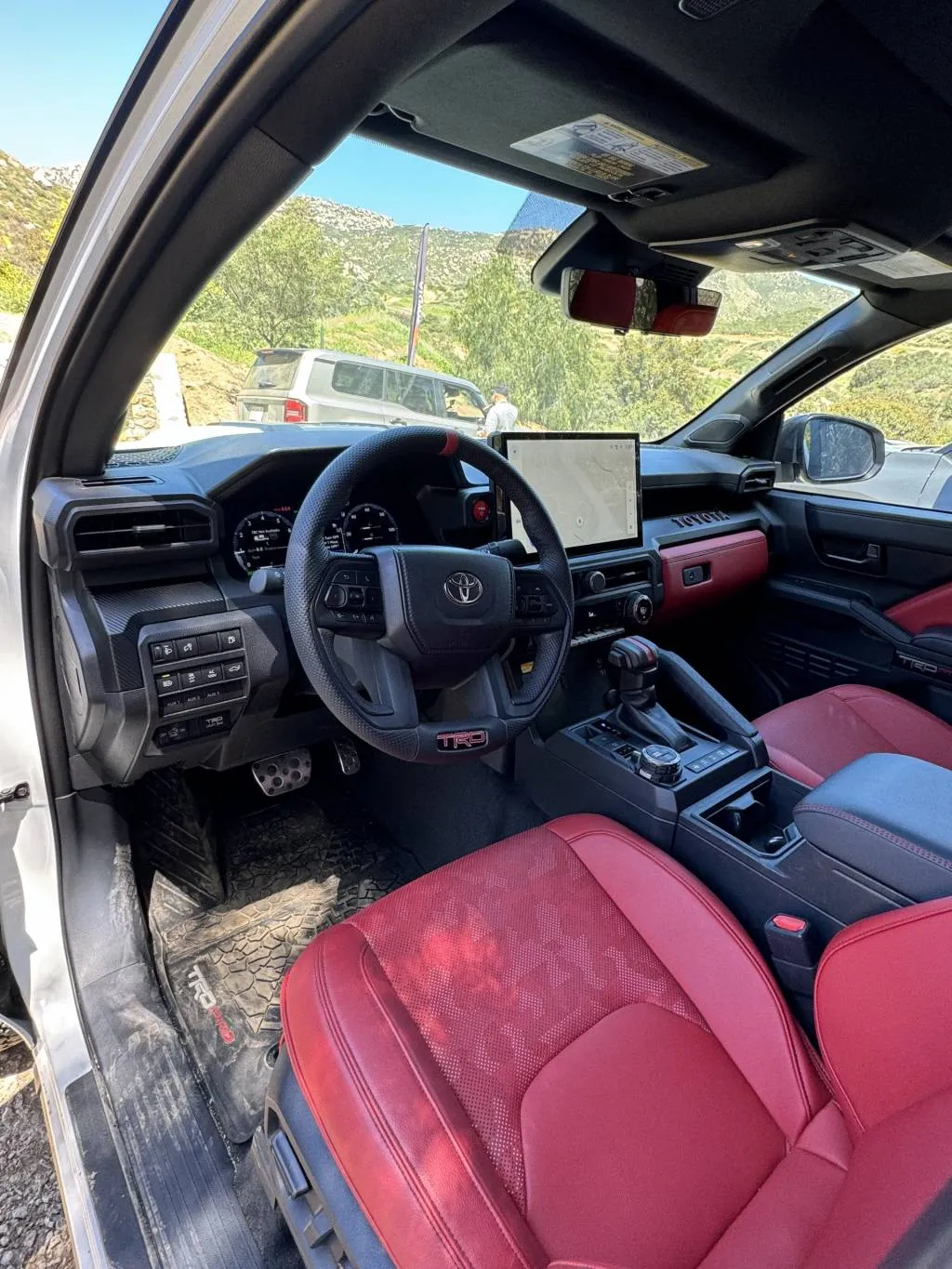
2024 Toyota Tacoma TRD Pro

2024 Toyota Tacoma TRD Pro
Inside, the TRD Pro’s cabin is mostly standard Tacoma fare. Chunky knobs and buttons serve as controls ranging from climate and audio functions to off-road features such as the rear locker. However, the front seats boast built-in shock absorbers to help with lateral stabilization while off-roading. They work. With air-pressure adjustments, these seats stabilize the driver’s body during high-speed off-roading for less jostling and fatigue. They might be the best seats in an off-road pickup, certainly in the midsize segment. The downside is the shocks, and their brackets, severely eat into rear seat legroom, taking it to “do I have to sit back there?” status.
In theory, I like the available red and black color schemes, but the required camouflage seat pattern is too Bro Truck for me. I could also do without the TOYOTA name stamped into the passenger side of the dashboard. Brown confirmed this is part of a three-piece molding and removing it would require the entire dashboard’s trim to be swapped out.
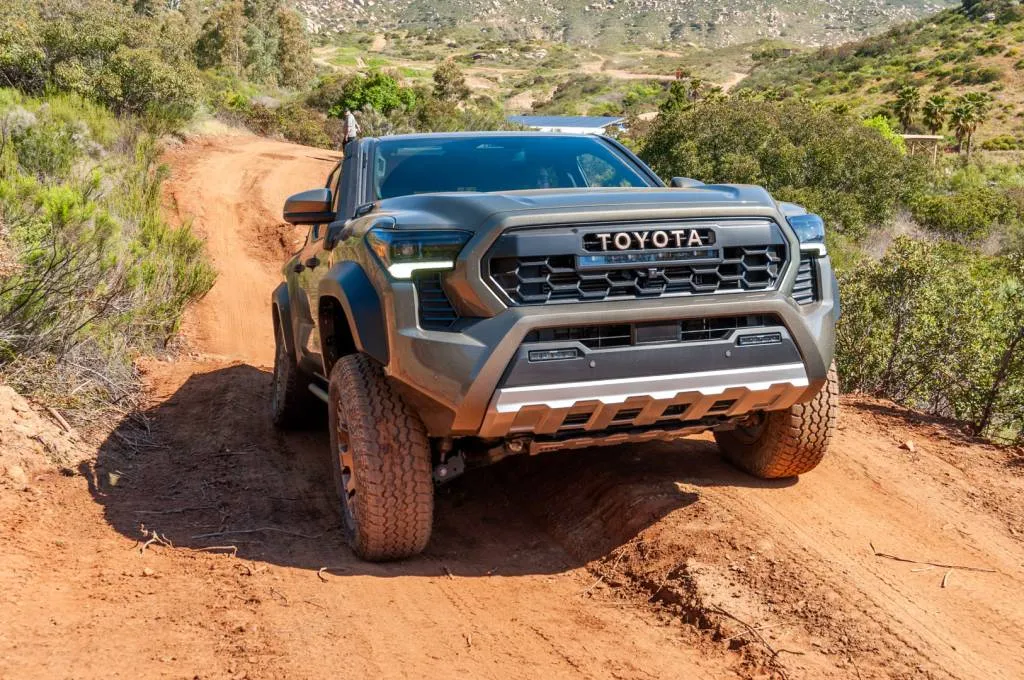
2024 Toyota Tacoma Trailhunter
2024 Toyota Tacoma Trailhunter likes to take it slow
Trailhunters swap out the TRD Pro’s Fox QS3 shocks for ARB Old Man Emu position-sensitive 2.5-inch shocks with small piggyback remote reservoirs. They are softer than the TRD Pro’s Fox shocks for less jarring movements while clambering over obstacles. I’ll be curious to test both trucks on the road to see the differences on pavement.
No Toyota on the TNGA-F platform (of which the Tacoma shares with the Toyota Land Cruiser, 4Runner, Tundra, Sequoia, Lexus LX and GX) offers a front locker; the chief engineer for the Lexus GX said “we don’t need it.” Maybe, but a Ford Ranger Raptor and Chevrolet Colorado ZR2 both have one.
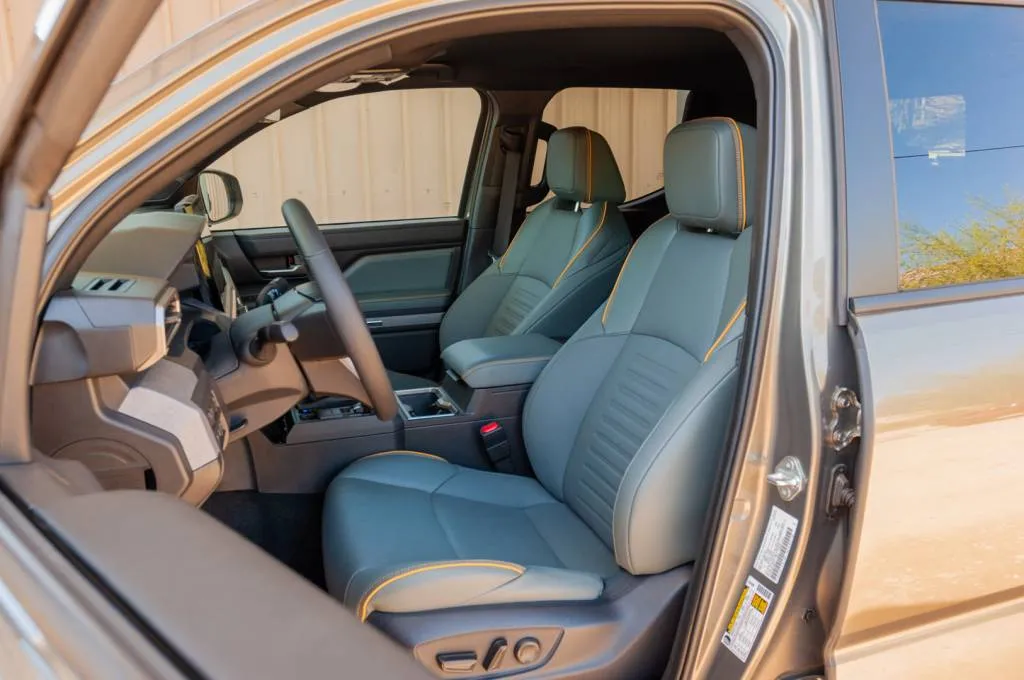
2024 Toyota Tacoma Trailhunter
The Trailhunter trades out the TRD Pro’s fancy front seats for standard Tacoma thrones. My tester’s seats were covered in synthetic leather in a mineral gray color trimmed with gold piping. The material was much more appealing to the eye than the TRD Pro’s camo-covered seats. They also make the rear seat tolerable, though the Colorado ZR2 still has more rear seat space with more comfort. The dashboard trim looks like it was cut out of granite with its matte finish, and the Toyota name is still molded into the passenger side of the dash.
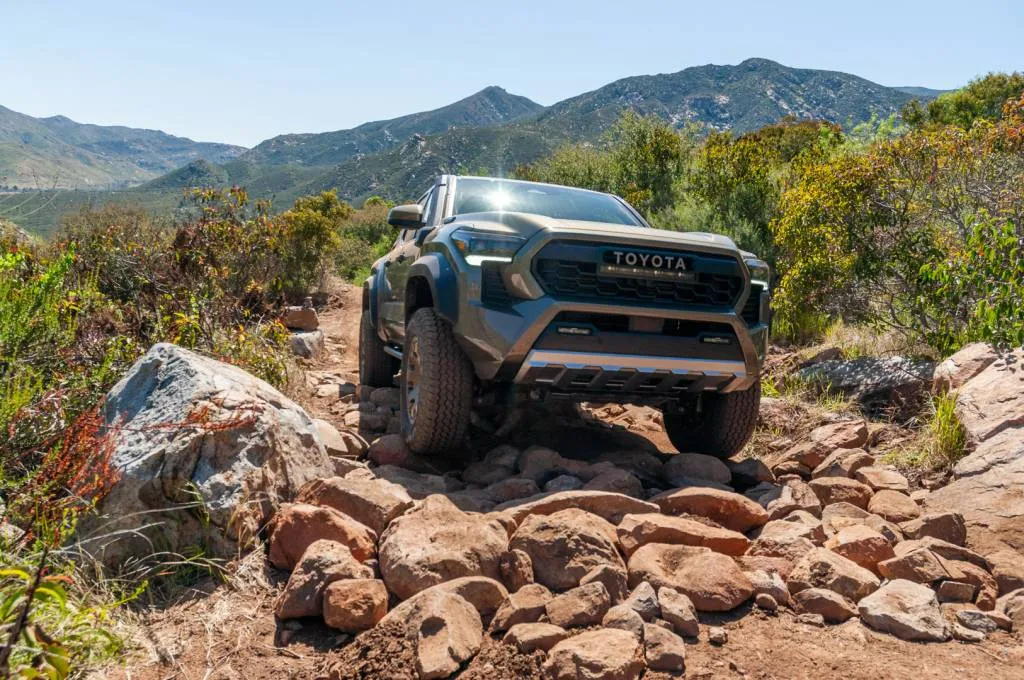
2024 Toyota Tacoma Trailhunter
2024 Toyota Tacoma Trailhunter and TRD Pro angles and capacities
Both the TRD Pro and Trailhunter only come in four-door crewcab body styles. While each can be had with a 5-foot bed, the Trailhunter is offered with a 6-foot bed for increased cargo capacity for off-road adventures.
Interestingly, the TRD Pro checks in with better off-road angles with 11.5 inches of ground clearance, a 35.7-degree approach angle, a 25.3-degree departure angle, and a 27.4-degree breakover angle. Those numbers eclipse the Trailhunter’s 11.0 inches of ground clearance, 35.2-degree approach, 22.3-degree departure, and 24.0-degree breakover angle.
Should a miscalculation be made when off-roading, the TRD Pro features 6-mm thick aluminum skid plates from the front end to the back of the engine. The Trailhunter upgrades these skid plates as they are made from high-tensile steel. Trailhunters also get a front skid plate that goes to the back of the engine, and adds skid plates for the transfer case, transmission, and rear differential. Both models feature a resin shield around the fuel tank.
Both the TRD Pro and Trailhunter come standard with an electronically disconnecting front sway bar for more suspension articulation. A touch of a button helps keep the front tires in contact with the earth. Ford and Chevy lack this neat feature.
Both trucks are rated to tow up to 6,000 pounds with the 5-foot bed, and the Trailhunter’s optional 6-foot bed drops towing capacity slightly to 5,950 pounds. Brown told me the Trailhunter will be the better tow vehicle as it’ll squat less than the TRD Pro.
The high-speed off-road TRD Pro is rated to haul up to 1,675 pounds of payload, while the Trailhunter is only rated to haul up to 1,475 pounds with the 5-foot bed, and that drops to 1,425 with the 6-foot bed.
Payload and towing match or best the competition. The Colorado ZR2 checks in with a tow rating of 6,000 pounds and is rated to haul up to 1,280 pounds of payload. The Ford Ranger Raptor is rated to tow up to 5,510 pounds and haul up to 1,375 pounds.
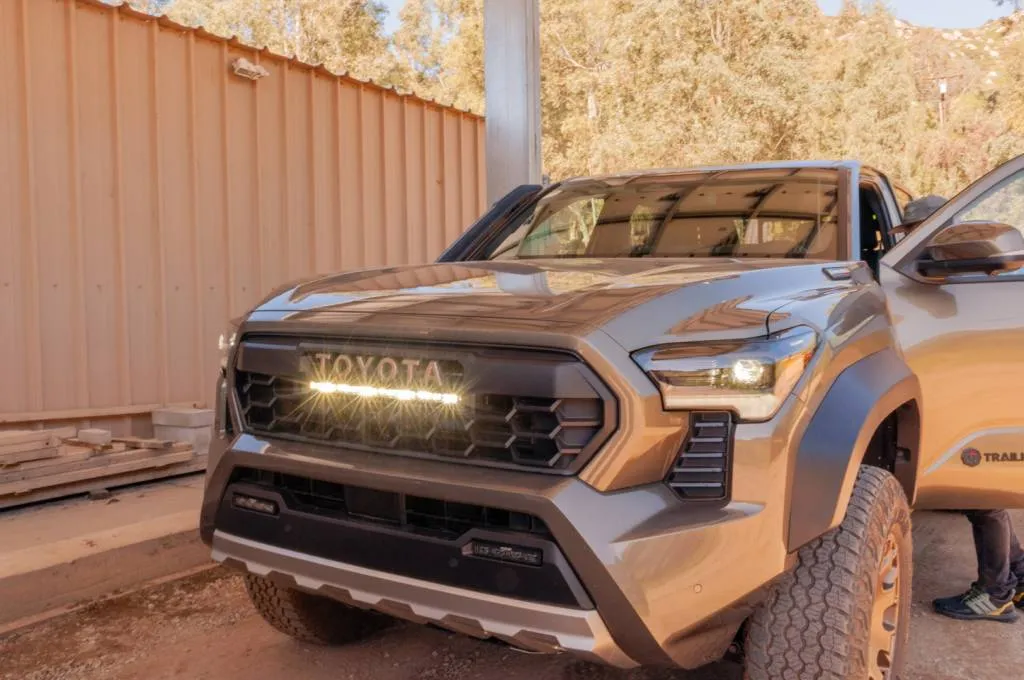
2024 Toyota Tacoma Trailhunter
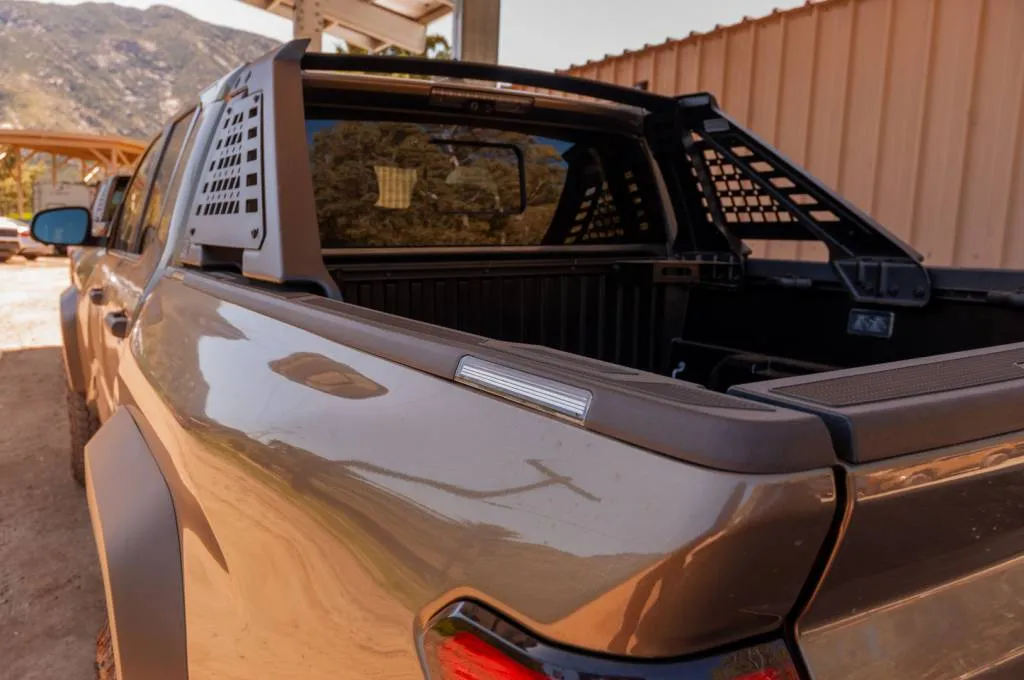
2024 Toyota Tacoma Trailhunter
2024 Toyota Tacoma Trailhunter and TRD Pro lighting
Both the Tacoma TRD Pro and Trailhunter include lightbars mounted in their grilles, but unlike the Tundra and Sequoia TRD Pros these lightbars will be more functional. The lightbars on the full-size vehicles only put out about 5,000 lumens. An $80 flashlight can create more light output than that. The lightbars on the Tacoma models have a 10,000-lumen rating. It was daytime when I drove the trucks, so judgment day will come later.
Both off-roaders feature LED driving lights mounted in their front bumpers, but the Trailhunter’s setup, provided by Rigid, can switch between cool white or amber. Neat trick. Trailhunter trucks also have white lights mounted on the bed rails that come on with the interior access lights. An ARB sport bar is mounted to the front of the bed with Molle panels to mount off-road gear. It’s a neat bit no other competitor has and it provides real functionality.
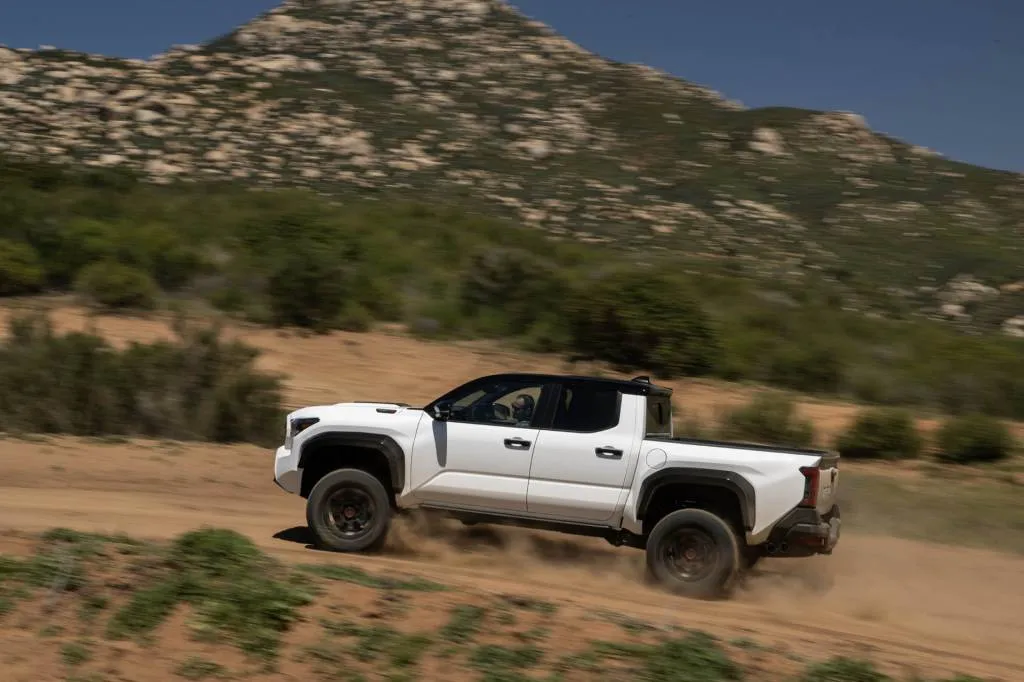
2024 Toyota Tacoma TRD Pro, photo via Nathan Leach-Proffer
2024 Toyota Tacoma TRD Pro and Trailhunter cost big bucks
Value isn’t baked into the Tacoma TRD Pro or the Tacoma Trailhunter.
The Tacoma Trailhunter costs $64,395 including $1,495 destination charge with the 5-foot bed, and another $500 should you opt for the 6-foot bed. The Tacoma TRD Pro costs even more at $65,395.
Those prices make the Chevrolet Colorado ZR2 look like an absolute steal at $48,790, and the Ford Ranger Raptor seem reasonable at $57,065. Both have front lockers and full-time four-wheel drive that the Toyotas lack.
The 2024 Toyota Tacoma TRD Pro and Tacoma Trailhunter both do a good job of fulfilling their mission. The TRD Pro handles the punishment of fast off-roading, while the Trailhunter is more adept when it comes time to pick your way down a trail.
However, given that the Ford and Chevy have more advanced shocks, full-time four-wheel-drive systems, Baja modes, and they both feel quicker, I’m left wondering how much the Toyota Tacoma name can justify the price premium. Those fancy seats with built-in shock absorbers are fantastic, but not $8,330-$16,605 fantastic.
Toyota paid for travel, lodging, and I got sunburned to bring you this firsthand report.
